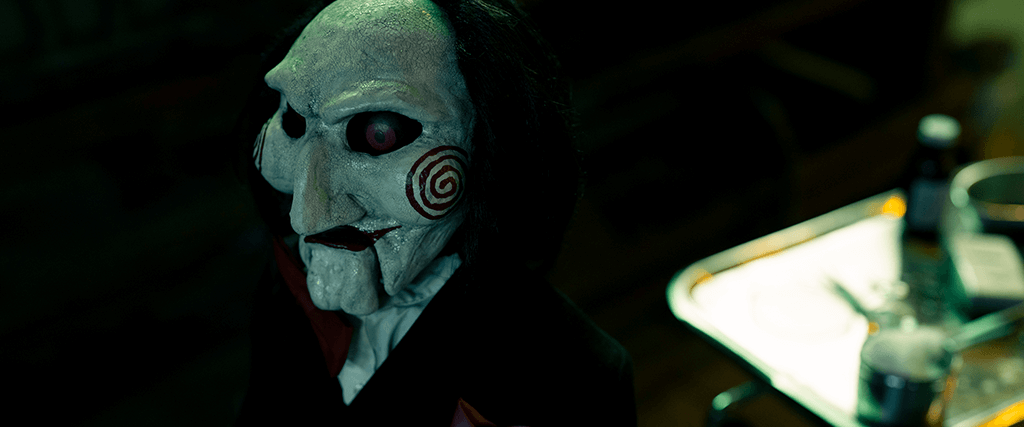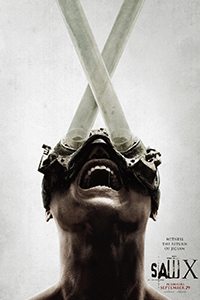Reader's Choice

Saw X
By Brian Eggert |
Imagine you wake up in a shadowy industrial space, unsure of how you got there. You cannot move, and metal contraptions have been attached to your head and appendages. The grim voice of the Jigsaw Killer echoes in the room, and he wants to play a game to teach you a vicious lesson. For this hypothetical, let’s say you’re a jaywalker. To survive, Jigsaw says you must slice off both feet, but there’s a time limit of three minutes. If you succeed, you can go free, and doctors can reattach your feet later; if you fail, a bomb strapped to your feet will explode, and you die. This is a typical situation built by the Saw franchise’s resident sicko. But I ask you, if you were in this situation and only cut off one foot, yet you were allowed to go free anyway, would you ever jaywalk again? Wouldn’t the experience of being held captive and forced into self-mutilation shake you out of what Jigsaw perceives as your disregard for the rules? What’s gained if you die? And why only three minutes? Wouldn’t you learn the same lesson if you had, say, an hour to remove your feet? Instead, because Jigsaw is an all-or-nothing maniac, he would rather dispose of a human life than merely scare you straight.
If you’ve watched the Saw movies, you know the killer’s would-be moralist schemes have a lousy track record. I found online that 22 people have survived in this series, while 64 have died. That’s just over a 25% success rate. After a while, you’d think John Kramer (Tobin Bell) and his apprentices would look at the numbers and question their strategy. (“Gee, we’re not helping many people. Maybe this isn’t the best method of reformation?”) Of course, we’re not dealing with someone interested in really helping people. His moral philosophy isn’t eye-for-an-eye logic; if you take an eye, he responds by putting your whole body in a meat grinder. That’s why it’s so difficult to watch drivel like Saw X, which takes the approach of reframing an established villain into an antihero by pitting them against someone worse—similar to the villains in Hannibal (2001), Don’t Breathe 2 (2021), or Orphan: First Kill (2022). With enough sequels, all movie killers become heroes; just look at Freddy Krueger’s transition from a pedophile and killer to a wacky cartoon figure whose face appears on children’s lunchboxes. Likewise, Jigsaw isn’t someone we should be asked to root for; however, this Part 10 goes to great lengths to establish circumstances that would morally justify his actions and earn the audience’s sympathy.
After the Saw franchise’s “Final Chapter” with 2010’s Saw 3D, Twisted Pictures and Lionsgate couldn’t resist further exploiting their cash cow. After all, Saw is among the most successful horror franchises of all time; to not produce more sequels would leave millions of dollars unearned, despite the franchise going creatively bankrupt long ago, perhaps from the start. After Saw 3D came Jigsaw (2017), which sought to reboot the brand but succeeded only in making the same mistakes one more time. A few years after that, Spiral (2021) supplied a Chris Rock spinoff with a neat concept but shoddy execution. In truth, the series has been spinning its wheels since Saw III (2006), the installment where John Kramer died. To track everything that followed, you would need a vast flow chart with arrows and diagrams to situate each movie and its victim on a timeline. Saw X contributes to the problem. Rather than another reboot, it’s a prequel of sorts—an isolated side mission between the events in the original Saw (2004) and Saw II (2005). It doesn’t add much to the overall series, and its lamentable attempt to imbue Jigsaw with a heart proves as misguided as the killer’s holier-than-thou agenda.
 Admittedly, I’ve never enjoyed the Saw series, and only out of a sense of completionism did I watch Saw X. I find Jigsaw’s modus operandi not only inconsistent and poorly conceived but also reflective of our culture’s basest desire for excessive punishment. “It’s not retribution,” John Kramer argues in Saw X. “It’s a reawakening.” But if he was so interested in supplying a renewal for his victims, he would be more concerned about his lackluster results. Jason Voorhees and Freddy Krueger have better reasoning in their singular appetite for revenge; Jigsaw is an insufferable, hypocritical nutjob making grandiose claims about his moral superiority, which is nothing more than a pretense to lash out at the world for giving him cancer. He doesn’t like the cards that fate dealt him, and he’s resolved to take it out on everyone around him—no matter how inconsequential their crimes (for instance, Cary Elwes’ character from the original Saw was held captive because he thought about cheating on his wife). At one point in Saw X, John spies a hospital orderly thinking about stealing a patient’s watch, prompting a daydream where one of his Jigsaw machines sucks out the orderly’s eyes unless he breaks all his fingers. That’s quite a leap for a misdemeanor. So it’s all the more nonsensical when the movie presents John as a sympathetic, moral hero rather than a wacko who punishes people for their impure thoughts.
Admittedly, I’ve never enjoyed the Saw series, and only out of a sense of completionism did I watch Saw X. I find Jigsaw’s modus operandi not only inconsistent and poorly conceived but also reflective of our culture’s basest desire for excessive punishment. “It’s not retribution,” John Kramer argues in Saw X. “It’s a reawakening.” But if he was so interested in supplying a renewal for his victims, he would be more concerned about his lackluster results. Jason Voorhees and Freddy Krueger have better reasoning in their singular appetite for revenge; Jigsaw is an insufferable, hypocritical nutjob making grandiose claims about his moral superiority, which is nothing more than a pretense to lash out at the world for giving him cancer. He doesn’t like the cards that fate dealt him, and he’s resolved to take it out on everyone around him—no matter how inconsequential their crimes (for instance, Cary Elwes’ character from the original Saw was held captive because he thought about cheating on his wife). At one point in Saw X, John spies a hospital orderly thinking about stealing a patient’s watch, prompting a daydream where one of his Jigsaw machines sucks out the orderly’s eyes unless he breaks all his fingers. That’s quite a leap for a misdemeanor. So it’s all the more nonsensical when the movie presents John as a sympathetic, moral hero rather than a wacko who punishes people for their impure thoughts.
If there’s anything novel about Saw X, it’s that writers Peter Goldfinger and Josh Stolberg patiently build the scenario, whereas previous installments have rushed headlong into the bloodshed. Not until halfway into the tediously long two-hour feature does someone die in a Jigsaw device. Before then, the story follows John, whose terminal brain cancer leaves him with a few months of life. After learning about a possible experimental treatment, he arranges to meet Cecelia Pederson (Synnøve Macody Lund), the daughter of a radical Norwegian doctor, to receive a miracle cure in Mexico City. When it turns out Cecelia’s solution was an elaborate scam, John and his assistant Amanda (Shawnee Smith) capture everyone involved. He claims it’s not about revenge, but what else would you call putting the people who conned you into elaborate torture devices? John’s notion of “reawakening” is a thin excuse for his gruesome crimes that never adequately justifies how he lashes out—especially when he failed to properly scrutinize the facts around Pederson’s claims before wiring her $250,000, thus living out the proverb that a fool and his money are soon parted.
Helmed by series editor-turned-director Kevin Greutert, the film looks flat and overly dependent on color filters—the usual seedy greens and yellows of the series—recalling the ugly aesthetic of mid-2000s horror. But at least the filmmakers forego the franchise’s choppy editing and chaotic camerawork. Saw X feels relaxed compared to most entries, like the filmmakers finally kicked the cocaine habit and settled into middle age. It’s also the best looking of the series, apart from maybe Jigsaw or Spiral, except Bell and Smith appear distractingly older than their characters might’ve looked between Saw and Saw II. Regardless, cinematographer Nick Matthews and Greutert arrange coherent scenes that unfold leisurely, including a toned-down score from what’s usually an abrasive barrage of industrial music on the soundtrack. The traps and deaths are no less nasty, however, with a self-performed brain surgery sequence standing out as a particularly gross addition. Indeed, the result might be involving except for the self-righteous narrative conceit, which is neither smart nor thoughtful nor particularly moving, regardless of the time it spends outlining the stakes.
In previous entries, Jigsaw’s philosophy was an afterthought to the frenzied bloodshed—a tedious, often inconsistent, and ill-conceived impetus to perpetuate onscreen torture and violence. (Remember when Jigsaw used to cut puzzle pieces off of his victims?) Here, the increased attention to John’s moral reasoning doesn’t strengthen his case or make him sympathetic, nor does it heighten the drama to today’s elevated horror standards, as the filmmakers seem to think it does. Instead, it reveals his plan to be sanctimonious and underscores his unaddressed psychopathy, while also reminding us that the nine earlier films are empty-headed nonsense. In the end, John’s skewed morals show one last time when John and Amanda walk off into the sunrise with an innocent Mexican boy they’ve rescued. John gives Cecelia’s bag of cash that she swindled from now-dead cancer patients to the boy. Why not give the money back to the families of Cecelia’s victims? But it’s evident neither John nor the filmmakers have put much thought into this, nor much about Saw X. No matter how much it wants to appear philosophical, and no matter how much John sees himself as the hero of his own story, I remain unconvinced by what is little more than a grim horror show about a nutter with a penchant for medieval death.
(Note: This review was originally posted to Patreon on October 17, 2023.)

Thank You for Supporting Independent Film Criticism
If the work on DFR has added something meaningful to your love of movies, please consider supporting it.
Here are a few ways to show your support: make a one-time donation, join DFR’s Patreon for access to exclusive writing, or show your support in other ways.
Your contribution helps keep this site running independently. However you choose to support the site, please know that it’s appreciated.
Thank you for reading, and for making this work possible.
Brian Eggert | Critic, Founder
Deep Focus Review




